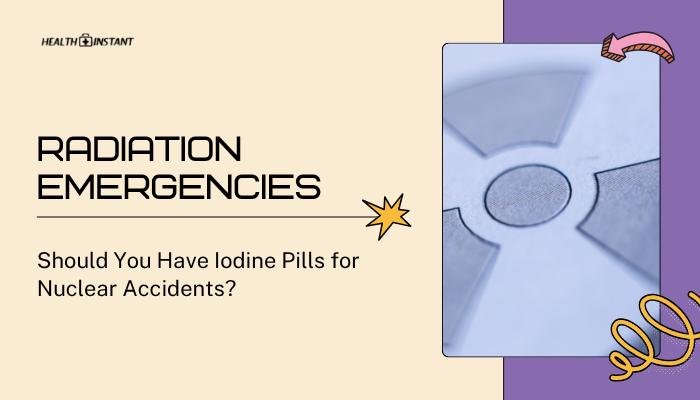Introduction
In the wake of potential nuclear accidents—whether from power plant malfunctions, radiological threats, or rare catastrophic events—people often wonder if they should have potassium iodide (KI) pills on hand.
These “iodine pills” can help protect the thyroid gland from radioactive iodine if taken correctly and at the right time. But is it a must for every household, and how do you use them safely? This guide clarifies what KI does, when to use it, and other steps to take during radiation emergencies.
Why Radiation Protection Matters
When nuclear incidents occur, radioactive isotopes may spread in the air and environment. One of these is radioactive iodine (I-131). If inhaled or ingested, it can accumulate in the thyroid gland, raising the risk of thyroid cancer, especially in children.
Taking stable (non-radioactive) iodine preemptively or during exposure floods the thyroid with safe iodine, thereby reducing radioactive uptake. However, it doesn’t prevent other radioactive elements from harming other organs.
What Are Iodine Pills?
Potassium iodide (KI) pills are the most common form of medical iodine used for emergency thyroid protection. Some governments distribute them to residents living near nuclear power facilities. Over-the-counter versions are also available in many regions, but experts advise using them only under proper guidance because they’re not a catch-all solution for all radiation.
How Potassium Iodide (KI) Works
The thyroid gland actively absorbs iodine (radioactive or stable) from the bloodstream. By saturating it with safe, stable iodide in advance, the gland takes up less or no radioactive iodine, greatly reducing potential radiation-induced thyroid damage. Key points:
- Timing Is Critical: Maximum effectiveness occurs if taken shortly before or immediately after radiation exposure.
- Limited Duration: A single dose blocks new radioactive iodine absorption for about 24 hours.
- Not a Generic Shield: KI does not protect other organs or from other radioactive isotopes (like cesium or plutonium).
When to Use Iodine Pills
- Official Directives: Rely on local authorities for instructions on if/when to take KI. They monitor radiation levels and can best judge the threat.
- Proximity to Nuclear Sites: Those within 10 miles (16 km) of a nuclear power plant are often recommended to keep KI on hand.
- Emergency Alerts: Follow government broadcasts or text alerts specifying distribution points or usage timing in a crisis.
If the accident risk is negligible in your region, stockpiling KI might not be necessary. Overuse can pose its own health risks.
Risks and Side Effects
- Allergic Reactions: Some individuals are allergic to iodine or experience rashes, swelling, or other symptoms.
- Thyroid Problems: Excessive stable iodine can disrupt normal thyroid function, especially in those with pre-existing thyroid disorders.
- Age Matters: Children and pregnant or breastfeeding women are top priority for KI administration to minimize thyroid cancer risks.
Always follow recommended dosing based on age, weight, and official guidelines. Never self-medicate with iodized table salt or unverified sources.
Storage and Availability
- Proper Storage: Keep KI in a cool, dry place; note the expiration date.
- OTC or Government Supply: Some areas near nuclear plants provide free KI to residents. Otherwise, it’s often found at pharmacies or specialized preparedness retailers.
- Check Local Regulations: Some regions place restrictions or require prescriptions for high-dose iodine.
Regularly check your supply and refresh it before expiration.
Other Protective Measures Against Radiation
- Shelter-in-Place or Evacuate: Follow instructions from officials. Often, staying indoors (with windows and doors shut, ventilation off) can limit external exposure.
- Distance: The farther from the radiation source, the less exposure.
- Time: Minimizing time near radioactive fallout lowers total dose.
- Protective Clothing: For some external contaminants, covering skin and hair helps reduce direct contact.
KI is a partial solution—comprehensive readiness involves evacuation planning and awareness of official advisories.
Conclusion
While potassium iodide (KI) pills can meaningfully reduce thyroid radiation in a nuclear accident involving radioactive iodine, they’re not a universal solution for all radiation risks. Following official health and safety instructions, properly timing doses, and preparing for broader protective actions (like evacuation) are crucial parts of nuclear disaster readiness.
If you live near a nuclear power station or in an area at risk of radioactive incidents, having KI on hand (and knowing when to use it) is wise, but always coordinate with local guidelines and maintain a well-rounded emergency plan.
References
- U.S. Food and Drug Administration (FDA). (2020). Guidance on the use of potassium iodide for radiation.
- Centers for Disease Control and Prevention (CDC). (2019). Radioactive iodine and thyroid protection.
- World Health Organization (WHO). (2018). Nuclear accidents: public health response.
- American Thyroid Association. (2021). Statement on potassium iodide and nuclear emergencies.
Disclaimer: This guide is informational only and does not replace professional medical or legal advice. Always follow local authority directives and consult healthcare providers for personalized instructions regarding potassium iodide and nuclear preparedness.


